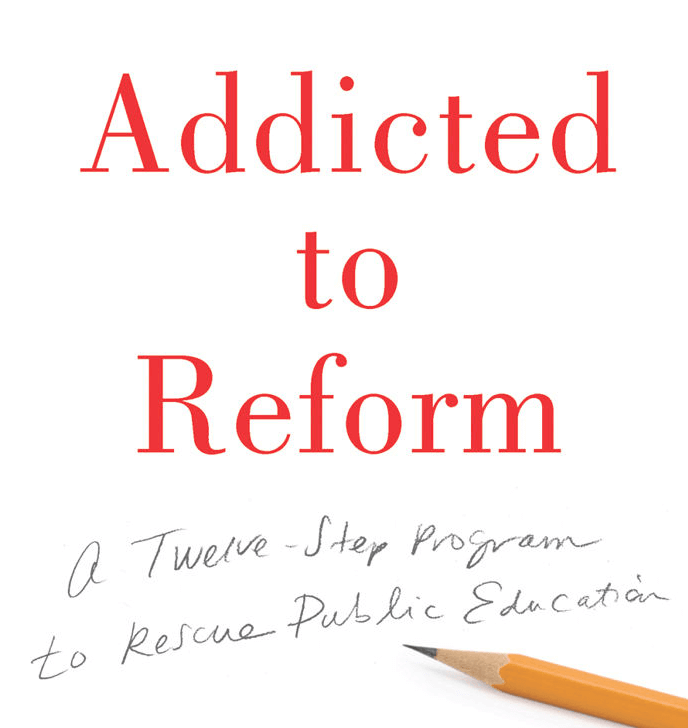It couldn’t have been financial hardships that drove teaching talent out of our state. After all, reports of state budget cuts are just fake news, at least according to Rep. Michael Rogers (R-Broken Arrow).
Seriously, there is no need to review, once again, the way that budget cuts have increased class sizes as the Legislature has failed to raise teacher pay. Clearly, these are contributing reasons for the majority of teachers leaving Oklahoma classrooms within five years of starting. (National attrition is almost as bad, however, with just under half of teachers leaving the classroom within that time period.) Dissatisfaction with the job ranks as a prime reason, and attrition gets worse in high-challenge schools like we have in the OKCPS.
The best way to understand the exodus of teachers from Oklahoma schools is to read award-winning reporter John Merrow’s Addicted to Reform: A 12-Step Program to Rescue Public Education (published Aug. 15 by The New Press).
‘Addicted to Reform’ explains the underlying issues
Before diving into Merrow’s writing, first, some historical background: Reforms enacted during President Barack Obama’s tenure put George W. Bush’s No Child Left Behind-type teacher accountability on steroids. In turn, the Obama-era policies mostly squandered the energies of educators on experiments that largely failed. It held individual teachers responsible for increasing test scores, thus coercing schools into nonstop remediation and worksheet-driven malpractice.
Merrow, with four decades of experience at NPR and PBS, recalls the legacies of “blindly worshipping test scores.” Under Arne Duncan, Joel Klein and Michelle Rhee et al. and with funding by the Billionaires Boys Club, test scores became more sought after than “the holy grail.” Merrow concludes, “Test scores are [reformers’] addiction, the equivalent of crack cocaine, oxycodone, or crystal meth.”
Two myths: the ‘heroic teacher and the ‘bad teacher’
In recounting the narrative of test-driven addiction, Merrow starts with the “heroic teacher” archetype that set educators up to fail in their supposedly single-handed fight against the legacies of poverty. He cites teachers’ accounts of how “the testing mania has caused people to lose their minds.” Teachers explain how they “are becoming more like McDonald’s workers.” As another teacher says, “I’m still in the classroom, but I miss teaching. It’s all about testing.”
When high-stakes testing was ramped up as a stick to be applied to every single educator, the result was predictable: “‘regurgitation education’ became the order of the day,” as Merrow documents. Accountability- and competition-driven reformers turned schools into dreary places for students “parroting back answers, while devaluing intellectual curiosity, cooperative learning, projects, field trips, the arts, physical education and citizenship.”
Merrow also recalls the “bad teacher” narrative that drove so much of school reform. The 2010 film Waiting for ‘Superman’ and The 74, an anti-union organization The Oklahoman often cites, as well as other corporate-funded public-relations assaults on public education, have “poisoned learning by turning it into a ‘gotcha game.’” Merrow concludes that our schools won’t be “out of the woods” until we “stop belittling and sometimes humiliating” teachers.
We can’t change the past, so let’s at least change the future
Had the stressful policies enacted under Obama worked, teachers would have kept up the extra work required to improve schools. Even though reformers often tout dramatic gains in meaningless state test scores, they ignore the reliable National Assessment of Educational Progress (NAEP) results. After years of incremental gains, NAEP scores have gone flat or declined as the achievement gap increased. Moreover, NAEP takers who weren’t drilled for state assessments score 9 points higher than those who were prepped.
As a result of the lavishly funded, data-driven mandates to transform “teacher quality,” only prison guards, child care workers and secretaries exhibit higher attrition rates. A seemingly conservative estimate is that 81 percent of teachers believe that schools have too much testing, which helps explain why 60 percent of teachers say they are losing enthusiasm in the job.
While money matters when seeking to improve the OKCPS, we must also listen to Merrow’s explanation of why attempts to “build a better teacher” to drive school improvement have failed. We must make being a teacher a “better job” by making education a “team sport.” Ultimately, our educators must be allowed to ignore test data while focusing on teaching in a meaningful and holistic manner.






















